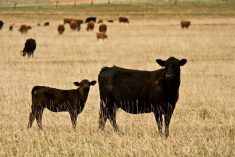For the week ending February 2, Western Canadian feeder cattle prices were up $6/cwt to $12/cwt from seven days earlier. Certain pockets of Western Canada had grass cattle trading $12/cwt to as much as $20/cwt above the previous week.
Major feedlot operators were active buyers in all weight categories. It appears that 600 pound steers are nearing the psychological $400/cwt level and 500 pounders are eyeing $450/cwt. There was limited slippage on fleshier animals while buyers were receiving “just get’em” type orders on quality genetic cattle.
The heifer discount to steers appeared to narrow on higher quality larger groups. However, smaller packages of heifers lagged the strength in the overall market. Backgrounding operators were having a difficult time picking up off grade types like bulls and late blooming stragglers. Cattle that need extra care to make grade were also in hot demand. Favorable weather has made processing a bit easier while transportation challenges continue to influence the market in some regions.
Read Also

New opportunities for Canadian goods in Mexico
Agriculture minister’s trip to Mexico sees promotion of Canadian goods like beef and canola, with potential for more partnerships in the future
Northwest of Winnipeg, Charolais blended steers on the card at 1000 pounds sold for $296. In Central Alberta, tan heifers around 920 pounds on light grain and silage diet with full processing data apparently sold for $278. Near Lethbridge, red steers weighing just over 900 pounds reportedly dropped the gavel at $312. In West-Central Saskatchewan, larger frame Simmental based steers carrying medium flesh averaging 855 pounds reached up to $319. In Central Alberta, tan mixed steers carrying medium to lower butter weighing 800 pounds silenced the crowd at $326.
In Central Saskatchewan, Angus based steers weighing 700 pounds were last bid at $359. South of Edmonton, larger frame red mixed heifers with lower flesh levels and full health records averaging 710 pounds supposedly traded for $323. In the same region, black weaned heifers weighing 680 pounds on forage diet were quoted at $315.
In Southern Manitoba, a smaller group of larger frame red weaned steers averaging 600 pounds reportedly sold for $395. In Central Alberta, smaller package of 510-pound Simmental Angus blend steers with 80 day weaning and full processing data traded for $445. In the same region, a smaller group of Angus heifers around 530 pounds with 75 day weaning and health records apparently sold for $362.
The USDA released their January 1, Cattle Inventory Report on Wednesday. The 2023 U.S. calf crop came in at 33.593 million head, down 847,000 head from the 2022 calf crop of 34.440 million head. Beef cows that have calved on January 1, 2024, were 28.2 million head, down 716,000 head from January 1, 2023. This was near-historic low beef cow number. The trade is anticipating significant heifer retention in 2024 which is contributing the strength in the feeder market.
— Jerry Klassen is president and founder of Resilient Capital, specializing in proprietary commodity futures trading and market analysis. Jerry consults with feedlots on risk management and writes a weekly cattle market commentary. He can be reached at 204-504-8339 or via his website at ResilCapital.com.












